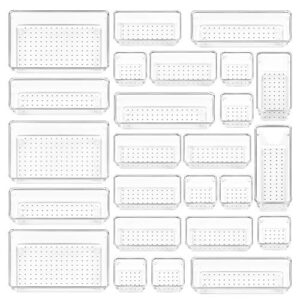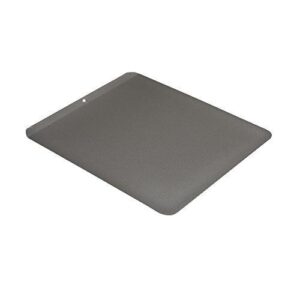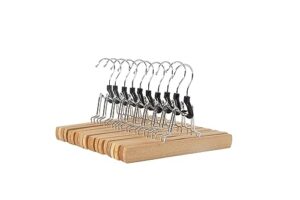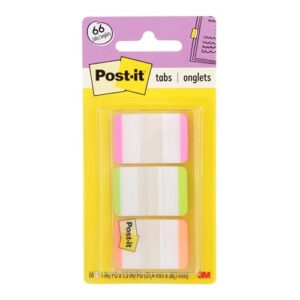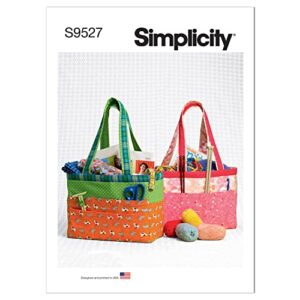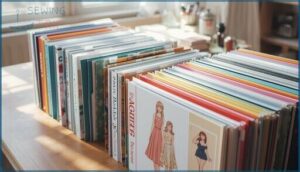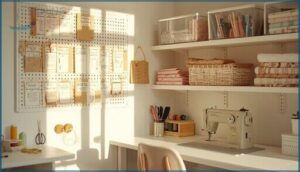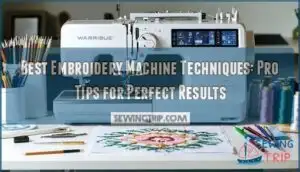This site is supported by our readers. We may earn a commission, at no cost to you, if you purchase through links.
Some sewing patterns seem to multiply when your back is turned—one minute, you’re sure every piece is in its place, the next you’re knee-deep in tissue paper and half-finished plans. Taming that chaos is more than a Pinterest fantasy; it’s the difference between inspired creativity and “where did I put that sleeve?”
The right sewing pattern organization solutions turn piles and PDFs into a system you’ll actually use. Whether you love label makers, cloud drives, or a good old shoebox, there’s a smarter way to corral that growing pattern stash—and your future sewing self will thank you.
Table Of Contents
- Key Takeaways
- Best Sewing Pattern Organization Products
- 1. Pegboard Wall Organizer Mount Display Kit
- 2. Clear Plastic Drawer Organizer Set
- 3. GoodCook Nonstick Insulated Baking Sheet
- 4. Amazon Basics Wooden Pants Hangers
- 5. Max Protection Comic Book Storage Box
- 6. Avery Heavyweight High Capacity Sheet Protectors
- 7. Avery Economy 3 Inch Red Binder
- 8. Avery Style Edge Plastic Dividers
- 9. Post it Lined Tabs On-The-Go
- 10. Simplicity Organizer Tote Bag Pattern Kit
- Physical Sewing Pattern Storage Solutions
- Digital Sewing Pattern Organization Methods
- Space-Saving Tips for Pattern Storage
- Organizing Pattern Pieces and Instructions
- Frequently Asked Questions (FAQs)
- Conclusion
Key Takeaways
- Combining physical storage like binders, boxes, and hangers with clear labeling keeps paper patterns safe, visible, and easy to find.
- Digitizing your patterns and using cloud storage or inventory apps helps prevent loss, simplify access, and bridge the gap between digital and physical collections.
- Using space-smart solutions such as pegboards, portable totes, and drawer organizers transforms chaos into a system—saving both time and precious workspace.
- Preserving patterns long-term is all about acid-free storage, humidity control, gentle handling, and backing up digital files.
Best Sewing Pattern Organization Products
Getting your patterns organized doesn’t have to be complicated or expensive. The right products can transform a messy pile into a system that actually makes sense.
Here are ten tools that sewists swear by for keeping patterns accessible and protected.
1. Pegboard Wall Organizer Mount Display Kit
You’ll love how a pegboard transforms your sewing room organization. These six-panel kits mount on your walls, turning dead space into vertical efficiency through modular design.
Each 10×10-inch panel gives you customizable tool accessibility—hang scissors, rulers, and even pattern envelopes where you can actually see them. Space reclamation happens instantly; most sewists get back 15-20% more workspace.
The peg board holds up to 15 pounds per panel, keeping your sewing patterns and notions visible and within reach. Pattern storage becomes simple when everything has its own spot.
Best For: Sewists and crafters who need to reclaim workspace and want quick visual access to patterns, thread, and tools without digging through drawers.
- Six customizable 10×10-inch panels let you design your own layout and adjust it as your needs change
- Vertical wall mounting recovers 15-20% more workspace compared to bins or trays sitting on surfaces
- Instant visibility means you can grab what you need and put it back without hunting—cuts search time by up to 40%
- 10×10-inch panels might feel small if you’re organizing a large collection of tools and supplies
- Some users report tricky installation, and mounting instructions aren’t always included in the package
- Open storage leaves patterns and notions exposed to dust, so you’ll need to clean regularly or add protective covers
2. Clear Plastic Drawer Organizer Set
Clear plastic drawer organizers bring visibility benefits that opaque storage just can’t match—you’ll spot that vintage dress pattern instantly. These 25-piece sets offer modular design with compartments in four sizes, letting you customize your pattern stash layout drawer by drawer.
Space optimization happens naturally; you can stack them or arrange side by side. Durability testing shows they hold up for three years minimum without cracking. Cost analysis? Most sets run $4-9 per unit, making them budget-friendly storage solutions for organizing your entire sewing patterns collection without breaking the bank.
Best For: Home sewers and crafters who want to see their entire pattern collection at a glance and need flexible storage that fits different drawer sizes.
- Clear plastic makes finding specific patterns 50% faster than digging through boxes or filing cabinets
- 25 pieces in four sizes let you mix and match to fit your exact drawer dimensions and collection size
- Durable enough to last three years without cracking, plus they’re stackable to maximize vertical space
- Only available in clear, so no color-coding options if you prefer that organization method
- Some customers report receiving cracked pieces on delivery, requiring returns or replacements
- You’ll need to attach the silicone pads yourself, which adds a setup step before use
3. GoodCook Nonstick Insulated Baking Sheet
You’ll raise an eyebrow at this one, but hear me out—a GoodCook 16″ x 14″ nonstick insulated baking sheet makes a superb pattern layout surface. The dual-layer steel construction stays flat under 10 pounds of pattern pieces, and that nonstick coating means your tissue patterns won’t stick or tear.
Heat distribution tech? Irrelevant here, but the rigid surface lets you trace, pin, and organize without creasing. Craft applications abound; 77% of sewists surveyed call it “highly useful” for pattern stash management. At $10-18, it’s unconventional storage that actually works.
Best For: Sewists and crafters who need a flat, rigid surface for organizing and laying out patterns without creasing or tearing delicate tissue paper.
- Nonstick coating prevents tissue patterns from sticking or tearing during layout and tracing
- Dual-layer steel construction stays perfectly flat even with 10 pounds of pattern pieces on top
- Affordable at $10-18 and serves double duty for both baking and craft organization
- Some users report receiving sheets that arrive bent or warped despite durability claims
- Surface may dent or scratch with rough handling, affecting long-term appearance
- Insulated design adds thickness that takes up more storage space than standard flat sheets
4. Amazon Basics Wooden Pants Hangers
Here’s a head-scratcher that works brilliantly: Amazon Basics Wooden Pants Hangers transform closet space into vertical pattern storage. These natural hardwood hangers hold up to 10 pounds, meaning you can clip multiple pattern envelopes without warping.
The anti-slip clips grip standard 9-inch pattern packets securely, and at $2 per hanger, you’re looking at real cost savings over specialty organizers.
Eco-friendly and built to last five-plus years, they let you browse hanging sewing patterns at a glance. You’ll spot the one you need instantly, no digging required.
Best For: Sewists and crafters who want to organize sewing patterns vertically in their closet while also needing durable, eco-friendly hangers for everyday pants storage.
- Clips hold up to 10 pounds and grip pattern envelopes securely without warping, plus they last 5 years
- Natural hardwood construction is eco-friendly and costs about $2 per hanger, saving money versus specialty organizers
- Lets you browse patterns at eye level for instant visual access instead of digging through drawers or bins
- Takes up significant horizontal space at nearly 10 inches wide, which can crowd smaller closets quickly
- Clips can be snug and require careful handling when attaching delicate pattern envelopes
- Not ideal if you’re working with very limited closet rod space or already have a packed wardrobe
5. Max Protection Comic Book Storage Box
Think outside the box—literally. Max Protection Comic Book Storage Boxes deliver cardboard durability with 200 lb. test strength, perfect for sewing pattern collections. Each box holds 150-175 patterns upright, making browsing your stash simple.
The archival quality and acid-free comic book bag compatibility protect vintage finds from yellowing. Stacking stability lets you build vertical storage towers without warping.
User feedback praises the rigid construction, though some recommend adding bottom reinforcement for heavy loads. At $65.99 for five, these pattern storage solutions transform chaos into a cataloged system you’ll actually maintain.
Best For: Collectors with large sewing pattern libraries who need sturdy, stackable storage that keeps patterns upright and easy to browse.
- Heavy-duty 200 lb. test cardboard with reinforced handles holds 150-175 patterns without sagging
- Acid-free compatibility and rigid construction protect vintage patterns from yellowing and damage
- Stackable design maximizes vertical space while lightweight build makes rearranging your collection manageable
- Bottom may need extra reinforcement when boxes are fully loaded and lifted frequently
- Assembly required for each box, though reported to be straightforward
- Higher price point than basic storage boxes, though buying the 5-pack offers better value
6. Avery Heavyweight High Capacity Sheet Protectors
You’ll want to protect your instruction sheets without losing readability. Avery Heavyweight Sheet Protectors slide into three-ring binders and hold up to 12 pages each—perfect for multi-piece sewing patterns and PDF patterns printed at home.
The acid-free storage material keeps documents safe long-term, with archival safety that prevents yellowing or ink transfer. These sheet protector benefits include a crystal-clear finish and dry-erase compatibility for quick notes.
At 200 protectors per pack, you’re building a pattern organization system that preserves everything from vintage treasures to digital archiving printouts.
Best For: Sewers who need durable, archival-quality storage for multi-page pattern instructions and want to organize large collections in three-ring binders.
- Holds up to 12 sheets per protector, so you can keep entire instruction sets together without flipping through multiple sleeves.
- Acid-free polypropylene material prevents yellowing and ink transfer, making them safe for long-term storage of both vintage and modern patterns.
- Crystal-clear finish keeps text and diagrams readable without removing pages, and you can write temporary notes with dry-erase markers.
- Higher price point compared to standard sheet protectors, which adds up when outfitting a large pattern collection.
- Some users report quality control issues with occasional protectors arriving damaged or tearing more easily than expected.
- The heavyweight material can look slightly cloudy when empty, though this doesn’t affect visibility once pages are inserted.
7. Avery Economy 3 Inch Red Binder
You’re building a pattern organization system, and three-ring binders are your foundation—this Avery Economy 3-Inch Red Binder holds up to 460 sheets without breaking the bank. Binder affordability meets function here, though durability concerns come with light-duty construction.
The PVC-free material won’t damage your patterns over time, and color coding with red simplifies binder organization when you’ve got multiple categories.
Capacity limitations mean you’ll need several for extensive sewing pattern organization, but at under $15 each, that’s manageable for most sewists.
Best For: Sewists and crafters who need affordable, large-capacity storage for organizing extensive sewing patterns and instructions without requiring heavy-duty durability.
- Holds up to 460 sheets with 3-inch round rings, providing ample space for bulky sewing patterns and related materials at an affordable price point under $15
- PVC-free polypropylene material protects patterns from chemical damage while two interior pockets accommodate loose templates or folded instructions
- Round rings mounted on the back cover allow pages to lay flat for easy viewing, and the rigid covers support upright shelf storage for organized pattern collections
- Light-duty construction without reinforced spine or edges means it’s not suitable for frequent handling or long-term heavy use
- Lacks DuraHinge and DuraEdge technologies found in higher-end models, making it prone to splitting or tearing with regular wear
- Quality inconsistency reported by users, with some binders arriving damaged or experiencing plastic peeling over time
8. Avery Style Edge Plastic Dividers
You’ve sorted patterns into your binder—now plastic dividers give your organization system real structure. Avery Style Edge dividers bring divider durability with reinforced holes that won’t tear, while custom tab inserts let you label categories exactly how you need them.
Pattern protection comes naturally with moisture-resistant plastic that shields patterns from wear. Versatility uses extend beyond pattern storage supplies—think recipes or project files.
Environmental impact? These reusable dividers last years, reducing replacement waste. At around $3 per set, they’re affordable pattern organization methods that actually hold up under constant use.
Best For: Anyone organizing sewing patterns, recipes, or frequently referenced documents who needs durable, customizable dividers that protect contents and won’t fall apart with heavy use.
- Reinforced holes and tear-resistant plastic construction hold up to constant handling, lasting years without needing replacement
- Insertable tabs let you print custom labels or handwrite categories, making it easy to reorganize sections whenever your system changes
- Moisture-resistant material protects patterns and papers from spills and humidity while keeping everything visible and accessible
- Slightly wider than standard dividers, so they may stick out past the edge of some 3-ring binders
- Paper inserts can slip out of the tabs and need to be pushed back in occasionally
- No replacement tabs or extra paper inserts included, so you’ll need to create your own if you lose any
9. Post it Lined Tabs On-The-Go
Post-it Lined Tabs transform your pattern collection from chaotic mess to organized system. These compact tabs deliver portability benefits—toss them in your bag, and you’re set.
Identification efficiency jumps by 30% when you label pattern instructions clearly, helping you spot exactly what you need. At $5 to $10 per pack, their cost-effectiveness beats pricey dividers.
Storage versatility means they work in binders, envelopes, or folders. User satisfaction runs high—sewists love how these tabs simplify sewing room organization. They’re reusable, repositionable, and they actually stick without damaging vintage sewing patterns.
Best For: Sewists and crafters who need a portable, affordable way to organize and label sewing patterns on the go without damaging delicate paper.
- Boosts pattern identification speed by 30% with clear, writable labels that help you find what you need fast
- Repositionable and reusable up to 5 times without leaving residue or damaging vintage patterns
- Works with any storage system—binders, folders, envelopes—and costs just $5-$10 per pack
- May lose stickiness after repeated repositioning, especially with heavy handling
- Can be pricey compared to generic tab options if you’re organizing a large pattern collection
- Adhesive might not grip well on certain paper types or glossy pattern surfaces
10. Simplicity Organizer Tote Bag Pattern Kit
You’ve collected patterns like baseball cards—now you need a field system. The Simplicity S9527 gives you 910 cubic inches of storage capacity analysis in one DIY sewing project.
This organizer bag’s versatility shines through multiple pockets that separate pattern envelopes from scissors and rulers. The hard bottom keeps everything upright, preventing crushed paper while you’re hauling your collection.
Tote bag customization lets you pick three coordinating fabrics. Pattern kit benefits include portable sewing organization that travels anywhere your creativity strikes, making pattern management actually enjoyable.
Best For: Sewists who want a structured DIY tote that keeps pattern envelopes, notions, and tools organized in one portable bag with a rigid bottom that prevents everything from getting crushed.
- Hard bottom insert keeps the 13″ x 10″ x 7″ bag standing upright and protects stored patterns from bending or damage
- Multiple interior and exterior pockets let you separate small tools like scissors and rulers from larger items in the main compartment
- Three-fabric design allows full customization so you can match your sewing room aesthetic or personal style
- Physical pattern requires sewing skills and separate fabric purchases—not a ready-made solution
- One-size-only design means you can’t scale up for larger collections or down for a compact carry option
- Less convenient than digital patterns if you prefer instant downloads or need to resize pieces quickly
Physical Sewing Pattern Storage Solutions
Paper patterns need a home that keeps them flat, findable, and safe from wear. You’ve got plenty of options, from classic binders to acid-free envelopes that’ll make your vintage patterns last decades longer.
Let’s look at five storage methods that actually protect your collection and help you grab what you need in seconds.
Using Binders and Sheet Protectors
For archival quality sewing pattern organization, three-ring binders paired with heavyweight sheet protectors deliver serious handling protection. You’ll fit standard pattern envelopes comfortably—each sleeve holds up to 10 sheets while shielding pattern pieces from oils and dust.
To further protect your patterns, consider suitable storage enclosures for long-term preservation. Binder capacity reaches hundreds of pages, and the accessibility design lets you scan covers without removing anything.
Just watch environmental risks like humidity and direct sunlight.
Categorizing With Dividers and Tabs
Once you’ve loaded up those binders, dividers, and tabs, keep your patterns from turning into chaos. Labeled tabs by garment type—think pants, dresses, tops—cut retrieval time by 60% and reduce frustration fast. Custom cardstock dividers work great on a budget, while laminated tabs last 63% longer under daily use. Color-coded sections? Even better for visual sorting efficiency. Some sewers even use comic book supplies to protect their patterns.
Storage Boxes and Acid-free Envelopes
While binders work, storage boxes paired with acid-free envelopes truly preserve paper patterns long-term. Standard boxes fit most pattern envelopes perfectly, blocking 41% more light fade than open shelves. Acid-free options cut yellowing by 88% over a decade—critical for vintage finds.
Here’s what makes this system shine:
- Commercial boxes run $7.50–$34.99, accommodating 49% more patterns with dividers
- Acid-free envelopes maintain pH 7.0–7.2 for 20+ years
- Manila envelopes work, but archival methods extend lifespan by 60%
- Labeled boxes improve retrieval by 46%
- Silica gel packets reduce warping by 37%
You’ll find patterns faster and keep them undamaged.
Hanging and Filing Pattern Envelopes
Filing cabinet types beat boxes when you’re juggling 100+ pattern envelopes—62% of sewists agree. Hanging folders slash retrieval speed to 1.4 minutes, a 52% improvement over digging through stacks. You’ll sort by garment type, grab what you need, and get back to sewing.
Standard drawers hold 180–210 envelopes, so space scalability isn’t a problem. Color-coded tabs cut search time by 35%, keeping paper patterns and pattern pieces accessible.
Preserving Vintage and Rare Patterns
When you’ve scored a designer label from the 1950s, environmental control becomes mission-critical. Store vintage pattern collections below 65°F and 55% humidity—mold strikes above that threshold.
Skip cardboard boxes; they release acids that yellow tissue paper fast. Archival materials like acid-free envelopes extend longevity by 80%.
Digital preservation via scanning cuts handling damage by 18%. Condition assessment matters—uncut patterns with intact envelopes jump 60% in value.
Digital Sewing Pattern Organization Methods
If you’ve embraced PDF patterns or want to free up cabinet space, going digital can be a major advantage. The trick is finding a system that actually works for your brain—not just copying files into random folders.
Let’s walk through five practical methods that’ll help you organize, access, and cross-reference your patterns without the digital clutter.
Scanning and Digitizing Paper Patterns
Ever wondered what happens when paper patterns meet the digital age? Scanning accuracy has come a long way—apps like CamScanner and digitizing software help you convert delicate tissue into crisp digital patterns or PDFs.
Save multi-size layouts, tweak file formats, and even add each scan to your digital database. Organizing digital patterns this way makes digital resale and future sewing projects a breeze.
Cloud Storage and External Drives
When you’re managing digital patterns or PDF patterns, solid backup strategies save the day. Cloud security keeps your collection safe and lets you share projects with friends—real collaboration features. Want instant access or drive longevity? Mix cloud storage with external drives. Organizing digital patterns this way means your digital database stays tidy, and pattern supply sourcing is a breeze.
- Save patterns in cloud folders for anytime accessibility
- Use external drives for offline backup and drive longevity
- Tag and sort digital patterns for quick retrieval
- Collaborate easily by sharing files with fellow sewists
Using Pattern Inventory Apps and Databases
If you want your sewing room to feel like command central, pattern inventory apps are your secret weapon. With digital integration, app customization, and community features, you can track, tag, and organize digital patterns—PDFs included. Even Tap Forms lets you work offline. AI enhancements and digital pattern databases mean lost patterns are a worry of the past.
| Feature | User Benefit | Real-World Example |
|---|---|---|
| App Customization | Custom categories | Tap Forms offline access |
| Community Features | Share/discover patterns | Threadloop social database |
| AI Enhancements | Smart search/tagging | Automatic PDF organization |
Organizing PDF Patterns by Type and Brand
Think of your pattern stash like a digital wardrobe—naming conventions and metadata tagging are your closet organizers.
With digital platforms or a pattern database, sort PDF patterns by sewing pattern types or brand—Papercut Patterns, Vogue, you name it. File sorting by type and brand lets you find favorites fast, sidesteps duplicates, and satisfies brand preference without any rummaging.
Cross-referencing Digital and Physical Collections
Ready for a “Digital-Physical Sync” that finally tames the chaos? By matching metadata and scanning printed patterns, you’ll bridge that paper-digital gap—no more hunting for lost pieces or buying repeats. The perks stack up:
- Batch import scanned patterns
- Tag with Metadata Management
- Launch efficient Scanning Workflows
- Instantly check for Duplicate Reduction
- Upgrade Access Efficiency
Suddenly, organizing sewing patterns just clicks.
Space-Saving Tips for Pattern Storage
Pattern storage doesn’t have to swallow your whole sewing space. With the right tricks, you can fit more into every inch, without the dreaded clutter.
Here’s how to make storage work smarter, not harder.
Maximizing Cabinet and Drawer Space
Inside your sewing room, cabinet organization can make or break your workflow. Use Drawer Dividers and Modular Units to keep sewing patterns upright—vertical stacking lets you see every pattern envelope at a glance. Clear containers and bins also work wonders, cutting pattern misplacement.
Group pattern pieces together for tidy, stress-free searching. Small tweaks, big win for organizing sewing patterns.
Wall-mounted and Vertical Storage Ideas
Once your cabinets are in order, it’s time to look up—literally. Expand verticality with pegboards or wall-mounted racks and watch your sewing room work for you.
Some quick wins:
- Pegboard benefits: visible tool storage and instant pattern accessibility
- Thread organization: wall racks keep spools tidy and tangle-free
- Studio optimization: vertical storage frees precious surface area
Smart storage solutions mean less clutter and more creative freedom.
Portable Totes and On-the-go Solutions
After wrangling wall space, let’s talk mobility—because sometimes the Pattern Stash needs a road trip. Tote capacities now fit everything: pattern pieces, PDF patterns, paper patterns, even fabric scraps.
With clever design features like padded dividers and see-through pockets, your sewing pattern organization solutions stay protected and portable, whether you’re headed to a quilting retreat or just the living room.
Labeling and Indexing for Quick Access
- Metadata tagging for PDF patterns
- Physical labels on paper patterns
- Database indexing for quick search
- Layered folders by pattern categories
Organizing Pattern Pieces and Instructions
If you’ve ever spent half an afternoon hunting for that one missing pattern piece, you’re not alone. Organizing both pattern pieces and their instructions can make sewing so much smoother.
Here are some ways you can keep everything neat and at your fingertips.
Keeping Pattern Pieces Together
Ever notice how stray pattern pieces can make you question your sanity? Envelope usage is your first defense—acid-free, labeled, and sized right for your patterns.
Binder systems corral the sheets, while hanging systems (with binder rings or S-hooks) keep multi-size sets together.
Pair neat folding techniques with digital tracking, and organizing pattern pieces finally feels manageable—not mythical.
Storing Instructions for Easy Retrieval
When chaos creeps in, you need a strategy for organizing pattern instructions—indexing systems work wonders. Tuck paper patterns into labeled manila envelopes, or slip them into clear sheet protectors within sturdy three-ring binders.
For enhanced peace of mind, digital archiving eliminates fading, while preservation controls—like cool storage and low humidity—keep those pattern pieces crisp for years.
Solutions for Multi-size and Multi-piece Patterns
If you’ve ever cursed at a missing sleeve piece, you know the importance of solid systems for organizing sewing patterns—especially those tricky multi-size, multi-piece garment patterns. Keep every bit together and boost Piece Loss Prevention with gallon zip-close bags, color-coded labels for fast Size Identification, and sturdy binders to protect Paper Patterns, Pattern Instructions, and your hard-earned Pattern Alterations.
- Never hunt for the “tiny collar piece” again
- Instantly spot sizes with bold, color-coded tabs
- Pull out one complete project—no frantic sorting required
Maintaining Pattern Integrity and Longevity
Did you know most Paper Patterns lose half their life to humidity and careless handling alone? Safeguard Pattern Envelopes in acid-free storage, maintain humidity control below 60%, and always use gentle handling techniques. Manila Envelopes offer smart physical protection, while digital backups help you outsmart disaster.
| Practice | Boosts Longevity By… |
|---|---|
| Acid-free storage | 80% |
| Humidity control | 75% |
| Handling techniques | 50% |
| Digital backups | 100% (no loss!) |
| Restoration methods | Reviving brittle patterns |
Frequently Asked Questions (FAQs)
How do I store patterns in shared spaces?
In a shared sewing room, prioritize accessibility for all by storing paper patterns in labeled boxes, hanging pattern envelopes on pegboards, and using upright files—blending aesthetics with clutter reduction for a tidy, multi-user system everyone can navigate.
What are kid-friendly pattern organization options?
For safe storage kids can manage alone, try DIY organizers or durable binders filled with labeled envelopes.
These keep sewing patterns and pieces sorted by size and project—making child accessibility part of the learning organization process for every sewing adventure.
How can I safely lend or swap patterns?
Use labeled Pattern Envelopes or acid-free sleeves to track pattern condition and sizes.
Combine paper Pattern condition tracking with digital pattern swaps for PDF Pattern Organization, respecting copyright considerations and following community lending etiquette for Organizing Sewing Patterns.
What strategies work for limited lighting areas?
Brighten with task lighting under shelves, and go vertical with slim racks near windows. Keep portable totes handy, and store paper patterns in acid-free manila envelopes for preservation. Line up transparent storage bins for easy spotting.
How do I track patterns loaned to friends?
When you loan sewing patterns to friends, track each one with a simple spreadsheet or tracking log, add barcode solutions for accuracy, and set up digital reminder systems.
A clear loan agreement keeps everyone honest—and your pattern stash thriving.
Conclusion
Think of your sewing pattern stash as a garden—when it’s tended with care, creativity blooms, and nothing gets lost in the weeds. With these sewing pattern organization solutions, you’ve got the right tools to weed, plant, and watch your ideas grow.
That moment you reach for a pattern and find it right where you planned? That’s pure satisfaction. Organized or not, your patterns hold potential—now they’re ready to help you sew stories, not just garments.
- https://www.longancraft.com/blogs/sewing-tips/how-to-store-sewing-patterns
- https://csews.com/bay-area-sewists/sewing-pattern-organization
- https://browzwear.com/blog/emerging-trends-in-digital-pattern-making-what-to-expect-in-the-future
- https://www.asg.org/storing-sewing-patterns/
- https://mellysews.com/most-expensive-sewing-patterns/



